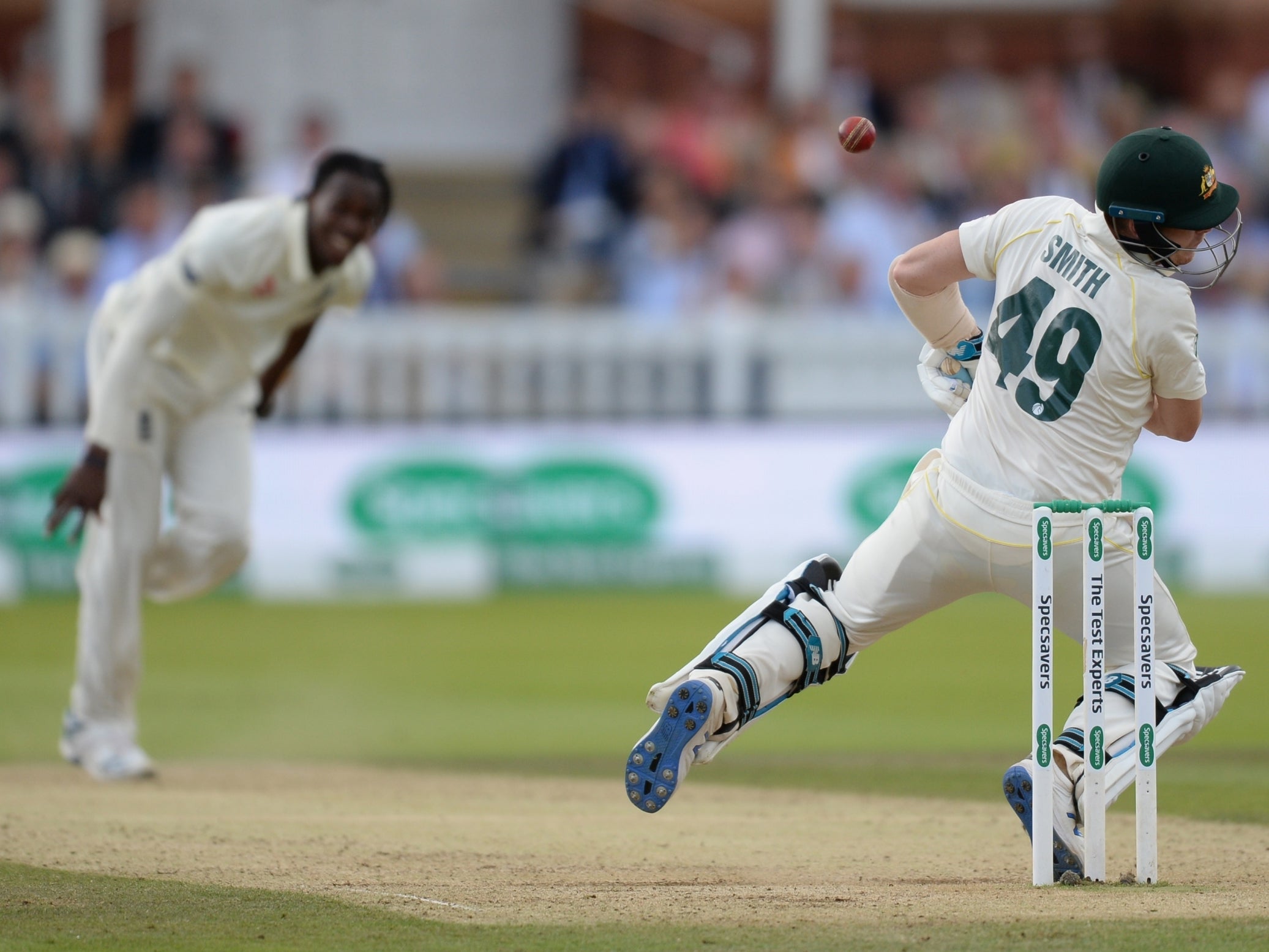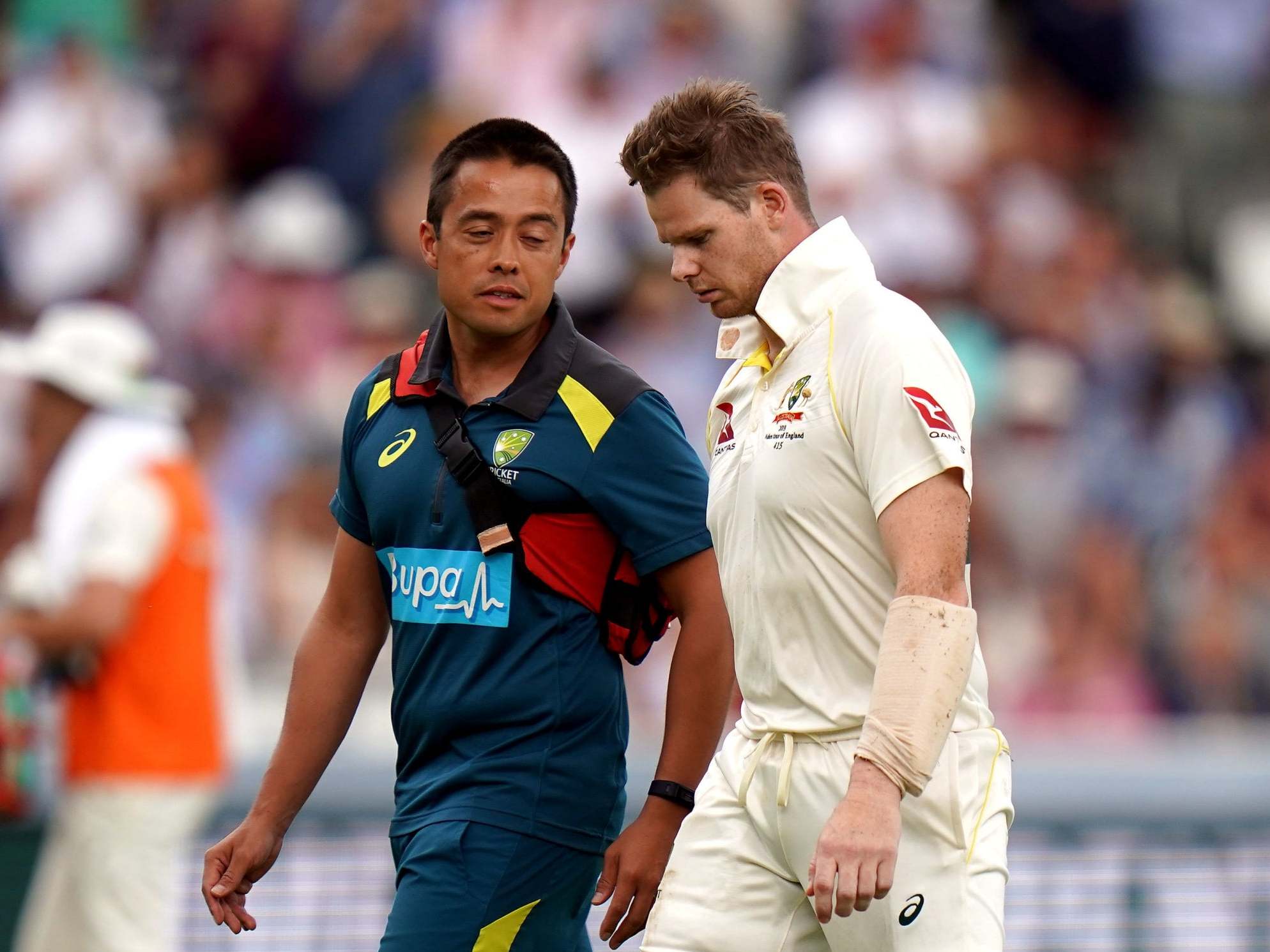Ashes 2019: Jofra Archer, pace and the psychology of facing cricket’s ultimate weapon
Steve Smith has been ruled out of the third Ashes Test after suffering a concussion after taking a blow to the head from Archer’s bouncer

Your support helps us to tell the story
From reproductive rights to climate change to Big Tech, The Independent is on the ground when the story is developing. Whether it's investigating the financials of Elon Musk's pro-Trump PAC or producing our latest documentary, 'The A Word', which shines a light on the American women fighting for reproductive rights, we know how important it is to parse out the facts from the messaging.
At such a critical moment in US history, we need reporters on the ground. Your donation allows us to keep sending journalists to speak to both sides of the story.
The Independent is trusted by Americans across the entire political spectrum. And unlike many other quality news outlets, we choose not to lock Americans out of our reporting and analysis with paywalls. We believe quality journalism should be available to everyone, paid for by those who can afford it.
Your support makes all the difference.Pace can do funny things to a batsman. A fact confirmed on a Saturday afternoon at Lord’s that, potentially, may have changed the entire direction of this Ashes series.
Steve Smith had previously been impervious to anything England’s bowlers could throw at him. Bouncer. Easy. Duck or hook. Away swinging length ball. No problem. Leave that well alone. Leg stump yorker. Whipped through mid-wicket.
All that, though, has changed. The brutal onslaught by Jofra Archer, didn’t so much shake-up the former Australia captain as leave him pole-axed and prostrate on the hallowed turf.
Okay, so he had already set an Ashes record by becoming the first player to make seven consecutive Ashes half-centuries, beating Mike Hussey’s previous tally of six, but all that was forgotten during a spell as quick as anything witnessed at the Home of Cricket.
Smith would return to the crease after initially retiring hurt but his mind was muddled. Soon after he left a Chris Woakes in-ducker as England dismissed him for less than 100 for the first time in the series. Australia have since ruled their talisman out of the third Test through concussion.
It now leaves a huge question mark, not just over his role in the remainder of the series but his ability to bounce back from the pasting he took at the hands of a bowler who was a teammate in the IPL for the Rajasthan Royals just a short time ago.
Smith’s continual ability to confound means it would be foolish for anyone to believe that Archer’s demolition job – which also included the Aussie receiving a dreadful blow on his arm – will have a long-term impact.
But here was evidence of the unique power of pace. Something that one former England player is all too painfully aware of.
Andy Lloyd of Warwickshire was 17 balls into his Test career when a short ball from Malcolm Marshall struck him in the right temple behind his eye. He wouldn’t play cricket again that summer – the incident happened in June – and would never play for England again. He lost 35 per cent of central vision in his right eye and openly admits that he was never the same player.
As brave as they come, Lloyd is living, breathing proof that batting isn’t always about scoring runs. When someone is bowling at well over 90mph – then your safety and possibly even your life, as well as your Test batting average, is under threat.
“Look, if you’re scared then you’ve got no chance,” he says. “The lad who got hit on Sunday (Marnus Labuschagne) got hit in a very similar way to me, fortunately he had a good enough helmet to bounce up, smile and carry on. The helmet I was wearing was like cardboard compared to the ones they wear now.

“If you’re worried about self-preservation then the bowler is 85 per cent of the way there to winning the contest. You need a completely different mindset and technique when you play a bowler bowling at the kind of pace Archer was at Lords – and there aren’t many quicks in world cricket these days who force you to do that.
“I can tell you right now that there will be a lot of mental things going on in that Australian dressing room before Headingley. Their best player and the best player in the world by a streak has been cleaned up a couple of times by Jofra.
“There’s no way that people in their dressing room aren’t saying to themselves, ‘Christ, I need to sort out how I’m going to play Jofra Archer’. They will be cranking up the bowling machine up big time. That’s what he has brought to the table.”

Former England one-day spinner Jeremy Snape once had his thumb broken by a Brett Lee thunderbolt on a tour Down Under and so, like Lloyd, has experienced high pace at first hand.
Now a leading psychologist for Sporting Edge, he says that the mental problems posed by facing bowling of well over 90mph are as intense as the physical reactions needed to play it.
“When someone is bowling at that pace, it’s a completely different game – you face spells that still give you cold sweats when you wake up in the morning,” he says. “The difference between facing bowling of 85mph to 90mph is a technical acceleration but it’s more psychological than physical. The more you feel it’s too fast, that plays out in your thinking.
“You can relax more and be more instinctive or you can get more tense. When I worked with the international players on facing fast bowlers you’re always trying to override a primitive system. Your brain, the emotional part of your brain, is trying to keep you safe.
“Your brain thinks about Jofra’s run-up being a little bit quicker, there’s a man at the short-leg – this has to be a bouncer. Your brain pre-loads what is going to happen so you’re ready early.
“Imagine a timeline from the left of your desk to the right of your desk. The very best batsman have that whole timeline, when the ball emerges from the fingers, they have that whole timeline to react and respond.

“If you’re the person who is relaxed, confident, in the zone and doesn’t see pace as a threat but as a challenge then the fight and flight response is heightened but not in a detrimental way. When someone starts thinking about getting hurt or worrying about it being too quick or being humiliated, then they try and second guess what’s happening.
“All of a sudden, they’re using the first third of that timeline focusing on the fact it might be a bouncer. Your weight shifts back because you’re ready to play a ball that’s chest high on the back foot. If it’s not short, then your timeline is significantly shortened and you have to undo some of the premeditated work you’ve already done.”
It’s a complex area and one that Archer has just made a whole lot more complicated for the Aussie batting line up and Steve Smith in particular.
“No-one wants to see anyone getting hurt but when you’re playing high pace then it’s always a possibility,” says Lloyd. “It’s a bit like driving a Formula One car, you don’t want to see anyone crash and get hurt but unfortunately it can happen.”
Archer is England’s Ferrari and Smith, Australia’s Rolls Royce batsman. They’re now on a collision course.
Join our commenting forum
Join thought-provoking conversations, follow other Independent readers and see their replies
Comments